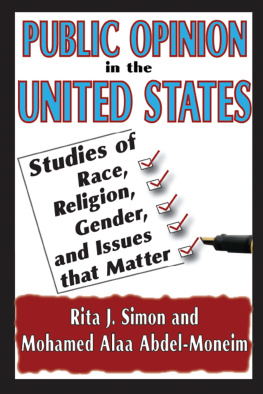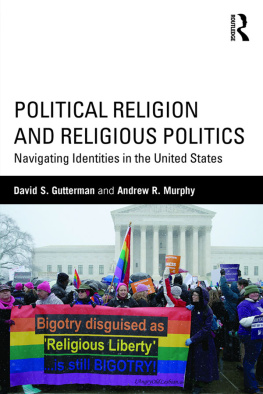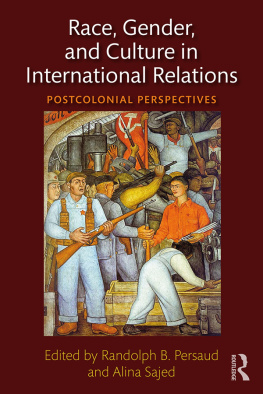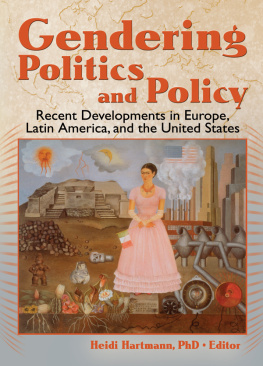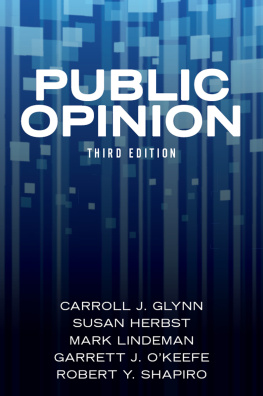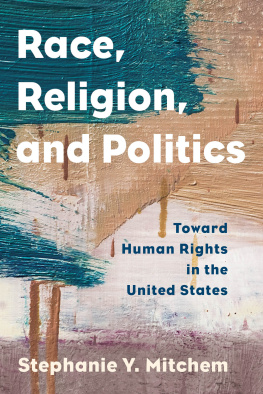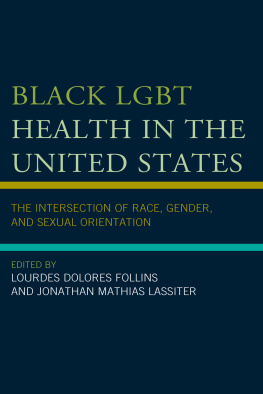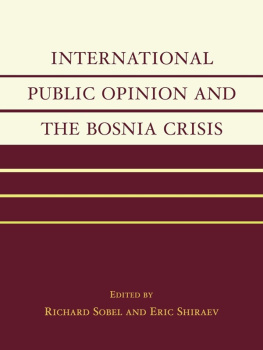PUBLIC OPINION in the UNITED STATES
PUBLIC OPINION in the UNITED STATES
Studies of Race, Religion, Gender, stnd Issues that Matter
Rita J. Simon and Mohamed Alaa Abdel-Moneim
First published 2010 by Transaction Publishers
Published 2017 by Routledge
2 Park Square, Milton Park, Abingdon, Oxon OX14 4RN
711 Third Avenue, New York, NY 10017, USA
Routledge is an imprint of the Taylor & Francis Group, an informa business
Copyright 2010 by Taylor & Francis.
All rights reserved. No part of this book may be reprinted or reproduced or utilised in any form or by any electronic, mechanical, or other means, now known or hereafter invented, including photocopying and recording, or in any information storage or retrieval system, without permission in writing from the publishers.
Notice:
Product or corporate names may be trademarks or registered trademarks, and are used only for identification and explanation without intent to infringe.
Library of Congress Catalog Number: 2009036452
Library of Congress Cataloging-in-Publication Data
Simon, Rita J. (Rita James), 1931-
Public opinion in the United States : studies of race, religion, gender, and issues that matter / Rita J. Simon and Mohamed Alaa Abdel-Mo-neim.
p. cm.
Includes bibliographical references and index.
ISBN 978-1-4128-1157-6
1. Public opinion--United States. 2. United States--Social conditions--Public opinion. I. Abdel-Moneim, Mohamed Alaa. II. Title.
HN90.P8S553 2009
303.380973--dc22
2009036452
ISBN 13: 978-1-4128-1157-6 (hbk)
To my mother, Amany, with all my love and respect -Mohamed Alaa Abdel-Moneim
Contents
The purpose of this book is to follow developments in American society since World War II through the lens of public opinion. We report and assess national public opinion poll data from 1945 to 2008. The targets are opinions vis--vis African-Americans, Jews, Muslim-Americans, gays and lesbians, immigration, abortion, and affirmative action. For some of the issues, poll data may not be available until later in the 20th century, but we shall report national data for each topic from the first survey until the present time, 2008.
Through these surveys we are exploring whether the society, for example, developed faster than the Supreme Court decisions, how it processed and responded to the race riots of the 1950s and 1960s, and how the war in Vietnam shaped new perspectives on issues such as race, citizenship rights, and the role of the individual. After analyzing the developments of public opinion toward the issues identified above, the following chapters will start by introducing political, social, or international events that we believe were critical in setting the stage for directing public opinion in each decade since the end of WWII. We then relate this to public opinion survey results during that decade.
Overall, our aim is to provide a portrait of American society and assess how it has changed or remained the same over the last sixty plus years. Are Americans more or less prejudiced against blacks, Jews, and Muslims than they were in earlier years? Have their views on immigration, affirmative action, and abortion changed and if they have in what direction? Do all groups in our society, e.g., men and women, rich and poor, more and less educated, and secular versus religious share the same views? Again if there are differences, what directions do those differences take?
In the end we shall be able to describe how similar or different American society looks in 2008 than it did in the post-World War II era and offer some glimpses into the direction it is moving. We are very much aware that in 2008, the American people elected their first African-American President.
As of the 2006 census data, African-Americans, at 36.7 million people, comprised 12 percent of the population.
The median age for the black community is 31 years. Four out of five black adults finished high school, compared with only one third in 1970 and 19 percent of black adults twenty-five years and older completed college. In 1970 only 4 percent had completed college. In 2005, 45 percent of black college graduates were married, among those without a high school diploma, 24 percent were married. The distribution of household incomes in black families between 1970 and 2006 is shown below.
The figures below indicate the black median income as a percentage of the white median income for 1976 to 2006.
We note that there has been little change over the past thirty years.
Table 1.1
Black Household Income: 1970 to 2006
Note: Figures are percent of total for that year. Earlier years adjusted to 2006 dollars. Blacks include Hispanic blacks.
Source: U.S. Bureau Census Income, Poverty and Health Insurance Coverage in the United States, 2006.
Table 1.2
Black Median Income as a Percentage of the White Median Income from 1976 to 2006
Year | % |
2006 | |
2000 | |
1997 | |
1986 | |
1976 | |
Although blacks make up only 12 percent of the population, they comprise 40 percent of the persons incarcerated in state and federal prisons. In 2005 blacks were about twice as likely as whites to be a victim of a crime.
We turn now to the public opinion data on the attitudes of white Americans toward blacks from 1945 to 2008.
National Poll Data
One of the earliest questions to appear on national polls was:
In general do you think Negroes are as intelligent as white people; that is, can they learn just as well if they are given the same education (and training) (NORC)?
The last time that item appeared on a national survey was twenty-one years later, in 1963. At that time, 76 percent answered yes. The same item appeared on national surveys at least four other times over the twenty-one-year period, with results as shown in Table 1.3.
Unfortunately, there is a gap of ten years during a period when some important institutional changes were occurring on this issue (between 1946 and 1956), which makes it difficult to trace the rate of opinion change. We note that in the four years between 1942 and 1946 (that is, during much of World War II), there was an increase of 11 percent. If we assume that opinions changed at about the same rate for the following decade, we would arrive at a figure close to the 77 percent that is reported for 1956. It is clear, however, from the percentages shown that the attitudes of white Americans shifted noticeably in the direction of greater acceptance of an inherent-equality doctrine.
Table 1.3
Percent Saying Negroes Are as Intelligent As Whites (19421963) (NORC)
Year | Percent |
1942 | |
1944 | |
1946 | |
1956 | |

